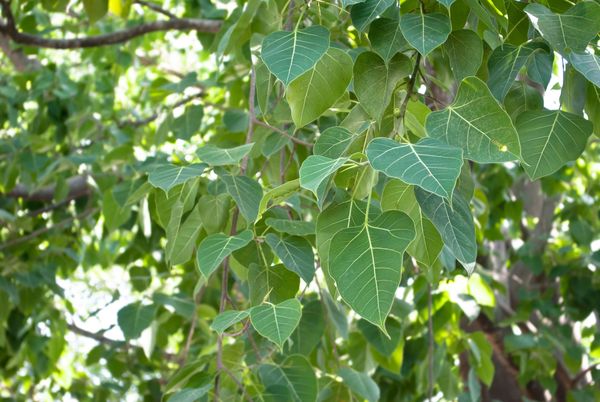
The Bodhi Tree, also known as the Mahabodhi Tree or Bo Tree, is a sacred fig tree located in Bodh Gaya, Bihar, India. It is widely known as the tree under which Siddhartha Gautama, the spiritual teacher who became known as the Buddha, attained enlightenment around 500 BCE. The tree is recognizable by its heart-shaped leaves, which are prominently displayed in religious iconography.
Although the original tree under which the Buddha sat is no longer living, the term “bodhi tree” is also applied to existing sacred fig trees. The Mahabodhi Tree, which is located at the Mahabodhi Temple in Bodh Gaya, is considered to be a direct descendant of the original tree and was planted around 250 BCE. It is the most important of the four main Buddhist pilgrimage sites and is a frequent destination for pilgrims.
Other holy bodhi trees with great significance in the history of Buddhism include the Anandabodhi Tree at Jetavana in Sravasti, North India, and the Sri Maha Bodhi Tree in Anuradhapura, Sri Lanka. Both are believed to have been propagated from the original Bodhi Tree.
The upkeep of the Mahabodhi Tree is assisted by the Forest Research Institute of India since 2007. Cloning of the tree was considered in 2008, and its sacred leaves can be bought by pilgrims as mementos. Religious offerings, which could attract insects, have been shifted to a distance from the tree to protect it.
According to Buddhist texts, Emperor Ashoka the Great was very diligent in paying homage to the Bodhi Tree and held a festival every year in its honour in the month of Kattika. In the 19th year of his reign, his queen, Tissarakkhā, cursed the tree to be killed by means of mandu thorns out of jealousy. However, the tree grew again, and a great monastery was attached to the Bodhimanda called the Bodhimanda Vihara.
In the ancient Buddhist texts, it is said that the Buddha himself sanctioned the planting of a seed from the Bodhi tree in Bodhgaya. This tree, known as the Ananda Bodhi, was planted in front of the gateway of Jetavana Monastery near Sravasti. To this day, it is revered as a symbol of transcendence and spiritual awakening.
The story of the Bodhi tree continues with King Asoka’s daughter, Sanghamitta, who brought a piece of the tree to Sri Lanka. This Bodhi tree, now known as Jaya Sri Maha Bodhi, is the oldest verified specimen of any angiosperm. It was planted in 288 BC, in the twelfth year of King Asoka’s reign. According to the Mahavamsa, the right branch of the Bodhi tree was brought by Sanghamittā to Anurādhapura and placed by Devānāmpiyatissa his left foot in the Mahāmeghavana.
Anuradhapura, Sri Lanka
The Bodhi tree was revered by Buddhists for its ability to bring rain and heal the ill. When someone became sick, their relatives would visit the tree and water it seven times for seven days, vowing on behalf of the sick for a speedy recovery.
Today, the Jaya Sri Maha Bodhi is the most sacred Bodhi tree, and it is continuously growing in the ancient capital of Anuradhapura. It is a powerful symbol of spiritual transcendence, healing, and the enduring legacy of the Buddha’s teachings.
Today, the Bodhi Tree is not just a symbol of the Buddha’s enlightenment, but also a symbol of awakening and enlightenment for all people. It reminds us that we all have the potential to awaken to our true nature and achieve enlightenment.
